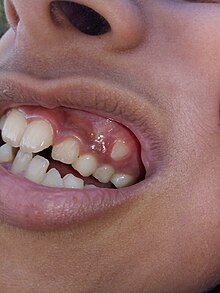
Back سوء الإطباق Arabic Maloclusió Catalan Zahnfehlstellung German Mala oclusión Spanish Maloklusio Basque ناهنجاری دندانی Persian Malocclusion dentaire French ליקוי סגר HE मालओक्कलूसन Hindi Malokluzija Croatian
| Malocclusion | |
|---|---|
 | |
| Malocclusion in 10-year-old girl | |
| Specialty | Dentistry |
In orthodontics, a malocclusion is a misalignment or incorrect relation between the teeth of the upper and lower dental arches when they approach each other as the jaws close. The English-language term dates from 1864;[1] Edward Angle (1855–1930), the "father of modern orthodontics",[2][3][need quotation to verify] popularised it. The word "malocclusion" derives from occlusion, and refers to the manner in which opposing teeth meet (mal- + occlusion = "incorrect closure").
The malocclusion classification is based on the relationship of the mesiobuccal cusp of the maxillary first molar and the buccal groove of the mandibular first molar. If this molar relationship exists, then the teeth can align into normal occlusion. According to Angle, malocclusion is any deviation of the occlusion from the ideal.[4] However, assessment for malocclusion should also take into account aesthetics and the impact on functionality. If these aspects are acceptable to the patient despite meeting the formal definition of malocclusion, then treatment may not be necessary. It is estimated that nearly 30% of the population have malocclusions that are categorised as severe and definitely benefit from orthodontic treatment.[5]
- ^ "malocclusion". Oxford English Dictionary (Online ed.). Oxford University Press. (Subscription or participating institution membership required.)
- ^ Bell B (September 1965). "Paul G. Spencer". American Journal of Orthodontics. 51 (9): 693–694. doi:10.1016/0002-9416(65)90262-9. PMID 14334001.
- ^ Gruenbaum T (2010). "Famous Figures in Dentistry". Mouth – JASDA. 30 (1): 18.
- ^ Hurt MA (2012). "Weedon D. Weedon's Skin Pathology. 3rd ed. London: Churchill Livingstone Elsevier, 2010". Dermatology Practical & Conceptual. 2 (1): 79–82. doi:10.5826/dpc.0201a15. PMC 3997252.
- ^ Borzabadi-Farahani, A (2011). "An Overview of Selected Orthodontic Treatment Need Indices". In Naretto, Silvano (ed.). Principles in Contemporary Orthodontics. IntechOpen Limited. pp. 215–236. doi:10.5772/19735. ISBN 978-953-307-687-4.
© MMXXIII Rich X Search. We shall prevail. All rights reserved. Rich X Search